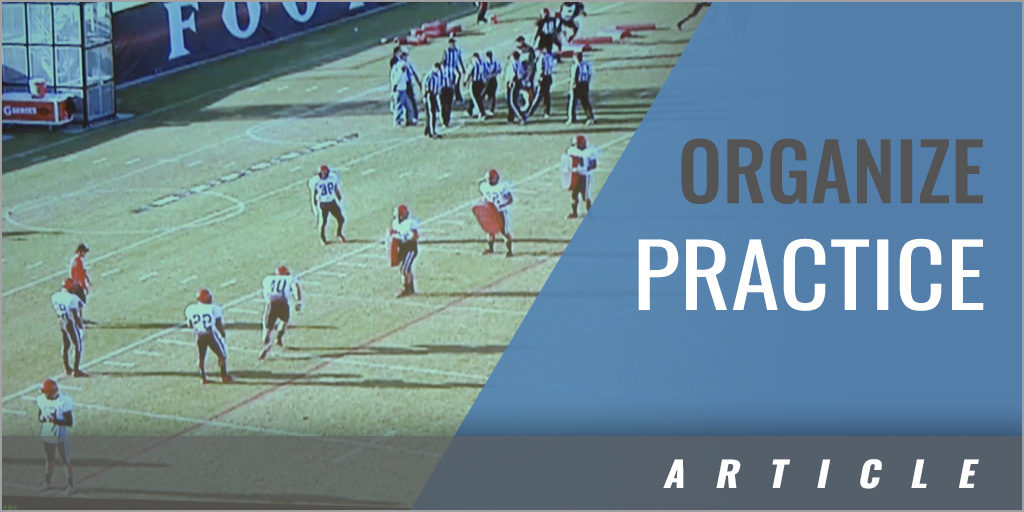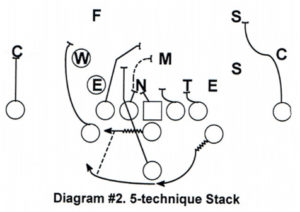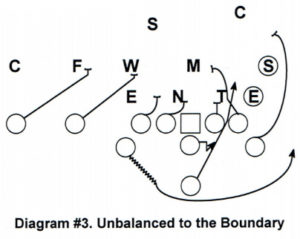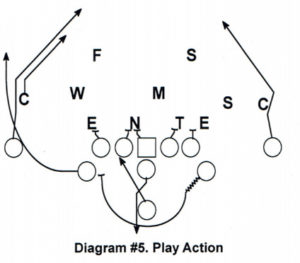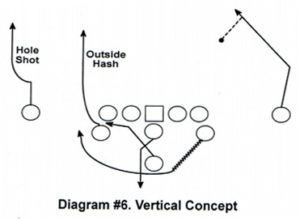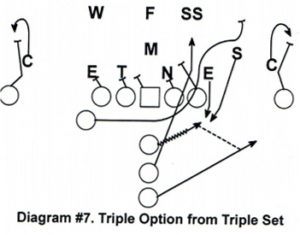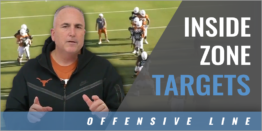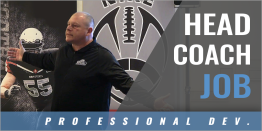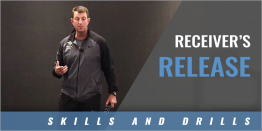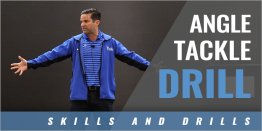|
By: Ian Shields - Jacksonville University Originally Published in: 2018 Nike Coach of the Year Clinic Manual - by Earl Browning Provided by: Nike Coach of the Year I want to thank the Nike Coach of the Year clinic and the Oregon High School Association for inviting me to speak this morning. I want to thank you for being here at 8:30 on a Saturday morning after an active Friday night. I appreciate you being here. I am going to talk about what we do at Jacksonville State with our spread option offense. We are a zone read triple option team. There is as good of football played in the northwest part of the country as anywhere in the United States. I have coached at a lot of places and have roots in Oregon, so I speak from an experience standpoint. I grew up on the playing fields in Oregon. There are multiple recipients of national honors that played and coached in Oregon. My dad coached football in Oregon. I grew up on the field of Oregon playing high school football. My roots in high school football is certainly not in the spread offense. However, I am passionate about what we do and I have made a career out of it. We do not have all the right answers, but this is what we believe in and how we move the ball. The Keys to Victory:
There are some things that are important to winning. This is our formula for winning games. I did not come up with this and they are certainly not original thoughts. I got this from Rich Ellerson. I worked for him at Cal Poly and Army. Coach Ellerson got it from Dick Tomey at Arizona. Coach Tomey got it from Bo Schembeckler and he got it from Woody Hayes when he worked for him. I am pretty sure that Woody Hayes got it from Moses on the tablets and I am sure he got it from God. This how you win football games. Everything starts with effort. We are not talking about good or great effort, we are talking about perfect effort. The average football play lasts for six seconds. If you are playing 70 snaps that is 420 seconds of football. That does not seem like a lot for all the running and training we do. However, that is what you are training your team to give fanatically effort. When we grade we grade their effort. We grade them on offense, defense, and the kicking game. The turnover battle is huge. I will get more into this. There are games that you lost that broke your heart because you could not take care of the football. There are games that you lost that will get you fired because you could not take care of the football. The kicking game is directly connected to field position in a game. How are we going to do these things? Perfect Effort:
On the practice field we should bring enthusiasm. We should be fired up to play the greatest game in the world. We want our guys to bring energy to their group. There are two types of players. Those that bring energy and those that take it away. There are energy vampires out there that suck the blood out of your program. We want those guys that bring energy to the program. We want guys that are getting the most out of each repetition. To put that into perspective, consider the 13 game season. If you play a 13 game season you spend about 40 hours playing the games. But you spend over 300 hours practicing for those games. That means you are practicing 7.5 hours for every one hour of game time. Our goal is to value practice reps as they relate to games, as a 1 to 1 ratio. We want our players to value those practice reps. Win the Turnover Battle:
We start off with the mindset of respecting the ball and the game. We work hard at studying the game of football. We have been fortunate to go and watch other college programs and professional team practices. It helps to work for coaches like Coach Ellerson and great coaches along the way, where the ball is a priority. The ball is the game. We want to make sure the ball is always in a LOCKED position. That is our term in our terminology. We want four points of pressure on the ball. We want the eagle claw with the fingers over the tip of the ball. We want the ball in contact with our forearm, bicep, and ribcage. We are never casual about the fundamentals associated with the football. We want to keep passion of the football and not compromise your chance to win. Ball security is not just for the quarterback and running backs. Everyone on the offense has to be conscious of ball security. If the left guard pulls the wrong way, runs into the quarterback, and the ball comes out, he has a role in ball security. The offensive line has to keep their defender away from our ball carrier by doing something called blocking. There is never an excuse for a turnover and we do not want to hear any. Every turnover is avoidable. The ball belongs to us and we are not going to give it away. One of the coaching methods we aspire to use is not telling them what to do. We want to tell them what to do. We want to plant that picture in their brain of the proper way to do things. That takes me back to my sophomore year at Oregon State. We were playing Oregon in the Civil War. It was right before halftime and we had the lead. The coach told me whatever you do, "Do Not fumble the ball." I went into the game. On the first play I got hit pretty hard and fumbled the ball. As a coach you do not want to put a negative picture into the player's brain. If you tell him not to do something that is what he see in his brain. We try hard to coach our players in what "to do and what not to do." Win the Mental Game:
We do not have a very big playbook. We are going to be who we are, and the defense is going to adjust to us. Staying in the moment is hard. There are too many things going on within a player's life. When he gets on the field is he thinking about his girlfriend, his parents, what happened last night, or some other thought. With all the social media today, it is hard to keep them focused on what they are doing. If you are down by 21 at halftime, can you still believe that the score board is a lie and you can come back? If you are up 28 at halftime, can you believe the scoreboard is a lie? You have to keep playing and stay on task. Win the mental game. The game of football is hard. It is difficult to win at the game. There will be ups and downs in the game. You are going to have good plays and bad plays. The most important play in a football game is the next play. That is the only one you can have control over. We tell our players to clear, load, and target. We want them to clear the previous play from their minds, whether it was good or bad. Load the next play and target the finish of the next play. That is part of the mental game for us. Each game has peaks and valleys. Momentum is a funny thing in a game. Players must learn situational football. We work all those situations in practice. We work clock management, short yardage, goal line and red zone. We must put them in those situations in practice so they can manage them in the games. Win the Critical Situations:
Coach John Wooden, who won 11 national championships at UCLA had a pyramid of success. At the top of that pyramid was "competitive greatness." By definition that means to be at your best when the best is needed. To accomplish that you must be poised, precise and aware of the situation. When you get to those situations you must be efficient. The last point is tremendously important. You must stop all the self-inflicted errors. You cannot jump in the critical situations. It happens all the time. Instead of being 3rd and two, you jump and it is 3rd and seven. We strive to be one of the least penalized teams in the country. You never want to beat yourself. We want to play hard enough to put the pressure on the other team. The first thing you can do to win a football game is not lose the game. When you talk about style that is talking about the identity of your team. Style of Play:
We know who we are. We know as coaches who we are. I think the way we play and the way the offensive line plays, lends itself to a culture of togetherness. We are going to be a physical football team. I think the offensive line sets to tone for the rest of our program. People are not used to how we play. In our offense it is important to talk about ball distribution. I heard Mike Leach from Washington State talk about ball distribution. Everywhere he has been the receiver gets the ball almost equal amounts of time. Being in Florida I can recruit receivers that can play. You must have a plan as to how you are going to get the ball to your playmakers. You have to divvy up the touches that each player gets. You do that in your game planning. The first time I was an offensive coordinator was at Eastern Oregon University, in 1997. I was at Oregon State for eight years and that is the longest I have been at any program in my career. When I was at Oregon State, we put in this system. We did not have a true option quarterback. He was more of a passing quarterback. The offense was more of a run and shoot type offense. This system has been flexible and adaptable over the years. We have tweaked it to fit the personnel we had coming back or whatever we inherited at a new job. When you become the head coach, you have to do what is best for the entire team and not just the offense. I like what we did with running the football. It helps our defense in both the games and in practice. That reflects the culture of togetherness. We are going to run the football on offense to limit the number of plays the defense has to defend. That helps us in the fourth quarter. In this system you can do more with less. There are school is that are "haves and those that are have-not" at all levels. If you are a "have" school, there are lots of things you can do within a system. They get the best recruits and have the best facilities. If you are a "have-not" you have to be a little different. I think you can be good with good personnel. We can play with lesser personnel and win games. That is how the Academies are winning games. They do not have the same personnel as big schools but win games because of the system. Philosophically with what we do with the spread option game is hard to prepare for. It can throw the defense off in their preparation. For us this 365 days a year and for the opponent it is 3 days to prepare. The defensive preparation for us is very challenging. Along with this you have to coach what you know. We have seen how defenses prepare for us and we have the answers for that preparation. This is a proven system because it has worked with all kinds of personnel. In our system we are 75 percent under the center and 25 percent in the shotgun. We have a split back formation, 3 X 1, or pistol. Our base play is the triple option. We are doing it two different ways. The first way is under the center, inside flex bone, with the inside veer. The other way is out of the pistol with a zone read triple option. We run an RPO, but this is the original RPO. Everyone is trying to run triple option football right now. Everyone in here is running some form of the option. Most everyone runs some kind of RPO. It all comes full circle. I think the triple option is the best play in the history of football. You are eliminating two defenders. You are leaving the backside C-gap player behind. The defense has to play assignment football. They have to play the dive, quarterback, pitch, and deep third. If you execute the play you are +1 in the blocking scheme. The option is the cheese that binds the entire offense together. Everything else we run is a compliment to the option. We run the flex-bone inside veer, the inside zone, and the play action pass off the plays. On the triple option, we align in a 2 x 2 winged set, which we call spread. (Diagram #1) The X-receiver is to the boundary and the Z-receiver is to the field. We have an A and C running backs in a wing set outside the tackle. The B-back is a hybrid fullback. The quarterback is under center. The defenses we see is a 4-3, 4-4, and 3-4. We will see variations from those defenses. Against the 1-technique nose guard, the center and playside guard double on him to the Mike linebacker. The backside guard and tackle are scooping their inside gaps. The 5-technique defensive end is the read key. The Will linebacker is the pitch key. The X-receiver blocks the corner aligned on him. The wing back to that side is going to block the force player. The right wing back comes in motion to a spot behind the fullback. The quarterback snaps the ball, rides the fullback, and decides whether to keep or hand the ball to the fullback. The fullback runs over the ball in the mesh area. He is aiming for the outside hip of the guard. There are some different things we do with playside tackle. On this particular play he takes an outside release. That puts the 5-technique in a real bind. Our quarterback two years ago had never been under the center in his life. He has a good football background but had never been under the center or run the triple option. I am okay with a four yard gain because 3 times 4 equals 12. We are going to move the chains. The quarterback steps out at 4 o'clock. He reaches back for the mesh area. He catches the fullback as deep as he can. The ride is from the back foot to the front foot. The quarterback has to make his mind up in that amount of time. If the hand off key is gray, we give the ball. If we cannot tell, we give the ball. If the key has his shoulders square to the line of scrimmage, that is a pull read. If the slants inside, that is a pull read. We pull the ball if the tackle does not close or steps outside. This the same play with a stack on the 5-technique defender. (Diagram #2) The quarterback sees the stack on the outside that is a pull/pitch read for him. Both the stack defenders are going to attack immediately. The playside tackle, takes an inside release and seals the backside linebacker or safety.
The reason this is a pull/pitch is because either the 5-technique or the Will linebacker can hit the B-gap as an initial charge. The offensive tackle takes an inside release. If the 5-technique slants, he washes him to the inside. If the Will linebacker runs the B-gap, the tackle blocks him. My leading receiver was the Z-receiver. In this set, the safety to his side leaves almost immediately to give support for the run. That leaves the corner on my best receiver by himself. We can win that if we want it. Another way to run the same play is to run it out of an unbalanced set. (Diagram #3) With the ball in the middle of the field, how is the defense going to adapt. We like to unbalance to the boundary side of the field and see what the defense does. We unbalance by bringing the Z-receiver to the boundary side and align him as an ineligible player.
The wide side of the field is the two-man blocking side. The defense will over-shift to the unbalanced and leave themselves a 1/2 man short to the wide side of the field. That is a lot of grass to cover and we have fewer defenders to block. We block down with the tackle and run the B-back past the defensive end. If we outside release with the playside tackle, the defensive end thinks the tackle is trying to reach him. (Diagram #4) If he steps out against the outside release by the tackle, the fullback will run wild. The center, and guard are blocking for the fullback. The tackle is blocking for the quarterback. We can run the same option from the wide slot and I-formation in the back field. Everything is the same except there is no lead back for the option. However, when we went to the wide slot, we pulled the pitch man out of the box. If the fullback receives the ball, there is another wrinkle from the same play, the fullback can cut the ball back into the A-gap. We can run a play action pass from this set. It is one of our favorite plays. (Diagram #5) We run the option fake. The playside back runs a wheel up the sidelines to the boundary side. The X-receiver runs a fake first to the block and then runs a post. The backside receiver runs to the post.
The reason to throw the play action pass is because the secondary is supporting the run so quickly. Play action passing slows them down. We have gone back and forth on the line blocking. We have toyed with man blocking and turn back blocking. If we turn back block, the fullback and backside back are the blockers to the outside on pass protection. One of the best passes we throw from the play action is the backside passing. We can run a post/corner, post, curl, or number of patterns. But to come backside away from the run action is an excellent way to get the ball to the receivers. Our passing game is so disproportionate that the play action passes are good most of the time. Our X-receiver is from Miami and is a flier. He runs great pattern and can win on most of them. However, he is not much of a stalk blocker, but he is a threat. Typically, we like to throw the ball back into the boundary. It is a shorter throw for the quarterback. We also have a vertical concept we run with the play action. (Diagram #6) The wide receiver runs his fake stalk then gets an outside release on the corner. He wants to get under control and look for the hole shot at around 18 yards. We are going to put the safety in the vise. The wing receiver is going to run vertical down the field outside the hash marks and the X-receiver is at the bottom of the numbers.
If you find a weak link in the secondary, they are all kinds of pattern you can run to take care of him. We like to reduce the split and get more room to work outside the corner. We call the reduced splits "flex." The receivers are going to be one-on-one most of the time. If they can win, you will have a big night. The next thing we do is to transition to a different backfield alignment. This is a zone read from a triple I in the backfield. The quarterback is in the shotgun with the A-back and C-back in the I-formation behind him. The remaining B-back aligns in a sniffer position behind the tackle. The X and Z receiver are still in their wide sets. From this formation we run zone and gap schemes. This is a triple option play to the right.(Diagram #7)
The line is going to the left. The B-back is going to the playside and block the force defender. The line is gap blocking to the left. The A-back is a stronger runner and is the dive back on the option. The C-back is the pitch runner. The quarterback does everything like the under center option. He still reads the number-1 man for the give or pull and the number-2 defender for the pitch. We are trying to create a numbers advantage. The perimeter blocking has to block four defenders. The quarterback blocks numbers 1 and 2. The B-back blocks the number-3 (force) defender, and the wide receiver blocks the number-4 (corner) defender. We can run the play to the B-back. He takes a counter off line step to put off the line of scrimmage by two yards. He reroutes his path to his block. The rest of the action is the same. The reads are the same. We tell our wide receiver that they want to leverage the secondary defender. Leverage to us means inside ear to the outside hip of the defender going north and south. We can run the play action passing game. From the formations. We are making people defend the run. That creates a lot of opportunity to throw ball off the play action fake. Most of our routes are two player routes. That means we should have a clean pocket to throw from. Most of the coverage we throw against is vanilla coverage with no elaborate schemes. But passing is not our game. We are a running triple option team. An example of a two man pattern is a post cut to the outside and a dig coming underneath it from the other side. Obviously we flex the split so we can get under the post when he goes. He takes the deep coverage and there is generally no underneath coverage. Last year we were predominately a no huddle team. But we were not in a hurry to get the ball snapped. This coming year we may go back to the huddle. I am going to have a rookie quarterback and I will need more control over the play calling. Guys I appreciate you being here this morning. If you every have the chance to come to Jacksonville, Florida we would love to have you there. I know that is a long way, but the beaches are a lot warmer. You are welcome any time. Thank you and I appreciate all you do for our kids. |
